Table of Contents
Understanding the Core Concepts
In the labyrinth of knowledge, there exist certain foundational principles that underpin various disciplines, guiding our understanding and shaping our perceptions. These are the core concepts, the bedrock upon which entire systems of thought are erected. From philosophy to physics, from literature to linguistics, every field has its fundamental ideas that serve as the compass guiding scholars and enthusiasts alike through the maze of complexity.
Unveiling the Core Concepts
At its essence, the journey of understanding begins with unraveling these core concepts. These are not merely abstract notions but rather the building blocks upon which the edifice of knowledge stands. To comprehend a subject deeply is to grasp its core concepts and appreciate their significance in shaping its framework.
The Role of Core Concepts
Core concepts serve multiple crucial roles in our intellectual endeavors:
- Foundation of Understanding: Just as a strong foundation is essential for a sturdy structure, core concepts provide the groundwork upon which deeper understanding is built. They offer a lens through which we perceive and interpret the world around us.
- Framework for Inquiry: In the pursuit of knowledge, core concepts act as guiding principles, directing our inquiries and investigations. They help formulate meaningful questions and avenues of exploration.
- Integration of Knowledge: Core concepts often serve as the glue that binds together disparate pieces of information within a field of study. They facilitate the integration of knowledge and the synthesis of ideas.
- Communication and Discourse: Effective communication within a discipline relies heavily on a shared understanding of its core concepts. They form the vocabulary through which experts communicate ideas and engage in discourse.
- Evolution and Innovation: Understanding core concepts allows for the identification of gaps, inconsistencies, and opportunities for innovation within a field. They serve as the springboard for advancing knowledge and pushing the boundaries of understanding.
Examples Across Disciplines
- Physics: In physics, core concepts such as mass, energy, and force are fundamental to understanding the workings of the universe. They form the basis of theories and equations that describe natural phenomena.
- Literature: Literary analysis relies on core concepts such as plot, character, and theme to dissect and interpret works of literature. These concepts provide a framework for understanding narrative structures and thematic elements.
- Psychology: Core concepts like cognition, behavior, and emotion are central to the study of psychology. They help psychologists explore the complexities of the human mind and behavior.
- Economics: Concepts like supply and demand, opportunity cost, and scarcity are foundational to the field of economics. They provide insights into the dynamics of markets, allocation of resources, and decision-making processes.
Performance Metrics Speed and Scalability
In the fast-paced digital landscape, where every second counts and user expectations soar higher than ever, the importance of performance metrics cannot be overstated. Among these metrics, speed and scalability stand out as the twin pillars upon which digital success is built. In this article, we delve into the significance of these metrics, their interplay, and how businesses can leverage them to stay ahead in today’s competitive environment.
The Need for Speed: Enhancing User Experience
In the digital realm, speed is synonymous with user satisfaction. Research indicates that even a mere one-second delay in page load time can lead to significant drops in conversion rates and user engagement. As attention spans dwindle and patience wears thin, users demand instantaneous access to content and services.
Performance metrics related to speed encompass various aspects, including page load times, server response times, and rendering speed. By optimizing these metrics, businesses can create seamless user experiences that captivate audiences and drive desired actions.
Scaling for Success: The Power of Scalability
While speed focuses on individual transactions or interactions, scalability looks at how systems perform under increasing workloads or user demands. Scalability is crucial for businesses experiencing growth or sudden spikes in traffic, ensuring that performance remains consistent and reliable even during peak periods.
Scalability metrics assess factors such as resource utilization, throughput, and response times under varying load conditions. By implementing scalable architectures and technologies, organizations can future-proof their digital infrastructure, accommodating growth without compromising performance.
Achieving Synergy: Speed-Scalability Balance
Speed and scalability are not mutually exclusive; in fact, they complement each other to drive optimal performance. A system that is fast but lacks scalability may falter when faced with surges in demand, leading to downtime or degraded performance. Conversely, a scalable system that sacrifices speed may struggle to deliver the responsiveness users expect.
Finding the right balance between speed and scalability requires a holistic approach, considering factors such as architecture design, resource allocation, and optimization strategies. By striking this balance, businesses can deliver lightning-fast experiences without sacrificing reliability or scalability.
Leveraging Performance Metrics for Competitive Edge
In today’s digital landscape, where competition is fierce and user expectations continue to rise, performance metrics serve as a crucial differentiator. Businesses that prioritize speed and scalability gain a competitive edge by delivering superior user experiences, fostering customer loyalty, and maximizing conversions.
Moreover, performance optimization isn’t a one-time task but an ongoing journey. Continuously monitoring and fine-tuning speed and scalability metrics allows organizations to adapt to evolving user behaviors and technological advancements, staying ahead of the curve in a dynamic digital ecosystem.
Ecosystem and Community Support
In the intricate tapestry of our world’s ecosystems, the significance of community support cannot be overstated. From the majestic rainforests to bustling urban centers, every environment thrives on interconnectedness and mutual aid. Let’s delve into the profound impact of ecosystem support and the pivotal role communities play in fostering their vitality.
The Interconnected Web of Life: Ecosystems embody the delicate balance of diverse organisms, each playing a crucial role in maintaining harmony. Whether it’s the microscopic bacteria enriching soil or apex predators regulating populations, every component contributes to the ecosystem’s resilience. However, this interconnectedness extends beyond species interactions.
Communities, whether human or non-human, form the backbone of ecosystem support systems. Human communities living in proximity to natural habitats often act as stewards, safeguarding biodiversity and promoting sustainable practices. Through conservation efforts, such as reforestation initiatives or wildlife protection programs, communities actively participate in preserving fragile ecosystems.
Strengthening Resilience: The resilience of ecosystems hinges on their ability to adapt to changing conditions. Natural disasters, climate fluctuations, and human activities pose continuous challenges to ecological stability. Yet, communities serve as a shield, bolstering the resilience of ecosystems through collective action and innovative solutions.
In coastal regions vulnerable to rising sea levels, community-based adaptation projects like mangrove restoration not only mitigate climate impacts but also provide livelihood opportunities for local residents. Similarly, urban communities implementing green infrastructure initiatives enhance the resilience of city ecosystems, combating pollution and urban heat island effects.
Cultivating Sustainable Practices: Sustainability lies at the heart of ecosystem and community support. By embracing sustainable practices, communities ensure the longevity of ecosystems while meeting their own needs. From renewable energy adoption to waste reduction strategies, communities champion environmentally conscious actions that benefit both society and nature.
Local farmers practicing agroecology, for instance, prioritize biodiversity conservation while producing food sustainably. Through crop diversification and natural pest control methods, these communities minimize environmental harm and promote ecosystem health. Such initiatives demonstrate the symbiotic relationship between community well-being and ecosystem sustainability.
Fostering Environmental Education and Awareness: Empowering communities with knowledge and awareness is paramount in nurturing ecosystem support. Education serves as a catalyst for change, inspiring individuals to become stewards of their surroundings. By fostering environmental literacy and promoting eco-friendly behaviors, communities lay the groundwork for a more sustainable future.
Community-led workshops, nature walks, and educational campaigns raise awareness about the importance of biodiversity conservation and ecosystem preservation. Through hands-on learning experiences, individuals develop a deep connection to their environment, fostering a sense of responsibility towards its protection. In turn, this heightened awareness fuels collective efforts to support and safeguard ecosystems.
Learning Curve and Developer Experience
In the dynamic realm of software development, the learning curve stands as an omnipresent challenge and a catalyst for growth. From novices stepping into the coding arena to seasoned developers navigating complex systems, mastering this curve is pivotal for individual and collective success. In this article, we delve into the intricacies of the learning curve and explore how enhancing developer experience contributes to a more efficient and fulfilling journey.
Understanding the Learning Curve
The learning curve embodies the process of acquiring new skills or knowledge over time. Initially steep, it gradually flattens out as proficiency increases. For developers, this curve encompasses grasping programming languages, frameworks, tools, and methodologies essential for crafting innovative solutions. However, the curve is not uniform for everyone. Factors such as prior experience, learning style, and available resources influence its trajectory.
Challenges Along the Curve
Navigating the learning curve poses several challenges. Novices often grapple with the overwhelming array of programming languages and technologies, leading to decision paralysis. Moreover, the rapid evolution of technology necessitates continuous learning, making it challenging to stay abreast of the latest trends and advancements. Additionally, imposter syndrome—a persistent fear of being exposed as a fraud—plagues many developers, hindering their confidence and growth.
The Role of Developer Experience
Developer experience (DX) encompasses all interactions developers have with tools, libraries, frameworks, and APIs throughout the development lifecycle. A positive DX minimizes friction, streamlines workflows, and fosters creativity. By prioritizing DX, organizations empower developers to focus on problem-solving rather than grappling with cumbersome processes. Furthermore, a supportive and inclusive community enhances DX by providing mentorship, collaboration opportunities, and emotional support.
Strategies for Enhancing Developer Experience
- Intuitive Tools and Documentation: Developers thrive when equipped with user-friendly tools and comprehensive documentation. Clear, concise guides and well-organized APIs facilitate seamless integration and troubleshooting.
- Continuous Learning Opportunities: Encourage continuous learning through workshops, webinars, and online courses. Investing in employee development not only enhances skills but also boosts morale and retention.
- Feedback-driven Improvement: Solicit feedback from developers to identify pain points and areas for improvement. Actively address issues raised to demonstrate a commitment to fostering a positive DX.
- Cultivate a Supportive Culture: Foster a culture of collaboration, knowledge-sharing, and psychological safety. Celebrate successes, provide constructive feedback, and offer mentorship to nurture talent and confidence.
- Embrace Automation and DevOps Practices: Automate repetitive tasks and embrace DevOps practices to streamline development workflows. Continuous integration, delivery, and deployment empower developers to focus on innovation rather than manual labor.
Project Requirements and Use Cases
Embarking on any project journey requires a meticulous understanding of its requirements and potential use cases. Whether you’re developing software, launching a new product, or executing a marketing campaign, clarifying the project’s objectives and envisioning its applications is paramount. In this article, we delve into the intricacies of project requirements and explore diverse use cases across various industries.
Understanding Project Requirements: Before diving into the execution phase, it’s imperative to define clear and concise project requirements. This involves conducting thorough research, engaging stakeholders, and aligning objectives with the overall project vision. A well-defined set of requirements serves as the blueprint for the project, guiding every subsequent step and ensuring alignment with stakeholders’ expectations.
Key Components of Project Requirements:
- Scope Definition: Clearly delineate the boundaries of the project, outlining what’s included and what’s not. This helps in managing expectations and avoiding scope creep.
- Functional Specifications: Detail the specific functionalities and features that the project must deliver. This involves outlining user interactions, system behaviors, and data processing requirements.
- Technical Requirements: Define the technological infrastructure, platforms, and tools necessary for project implementation. Consider factors such as scalability, performance, security, and compatibility.
- Quality Standards: Establish metrics and criteria for evaluating the quality of deliverables. This includes factors like usability, reliability, efficiency, and maintainability.
- Timeline and Milestones: Set realistic timelines and identify key milestones to track progress and ensure timely delivery. This involves estimating effort, allocating resources, and managing dependencies.
Exploring Use Cases: Once project requirements are defined, it’s essential to explore potential use cases to unleash the full potential of the solution. Use cases provide practical scenarios illustrating how the project can address specific needs, solve problems, or create value for end-users. Let’s explore some common use cases across different domains:
- E-Commerce: For an e-commerce platform, use cases may include online shopping, order management, payment processing, and customer support. Personalized recommendations, seamless checkout experiences, and inventory management are crucial functionalities.
- Healthcare: In healthcare, use cases range from electronic health record (EHR) management and telemedicine consultations to medical diagnostics and patient monitoring. Integration with wearable devices, AI-powered diagnostics, and remote patient monitoring enhance healthcare delivery.
- Finance: In the financial sector, use cases encompass banking transactions, investment management, fraud detection, and risk analysis. Features like secure transactions, real-time analytics, and personalized financial advice cater to diverse customer needs.
- Manufacturing: In manufacturing, use cases may revolve around supply chain management, production optimization, predictive maintenance, and quality control. IoT-enabled sensors, predictive analytics, and automation improve operational efficiency and product quality.
Database Integration and ORM Support
In the ever-evolving landscape of digital enterprises, efficient data management stands as a cornerstone for success. Amidst the myriad of technologies available, the integration of databases and the adoption of Object-Relational Mapping (ORM) support emerge as pivotal strategies. This article delves into the significance, benefits, and best practices surrounding database integration and ORM support in modern business frameworks.
Understanding Database Integration:
Database integration refers to the seamless incorporation of various databases into an organization’s infrastructure. It involves consolidating data from disparate sources into a unified platform, enabling streamlined access and analysis. Whether it’s relational databases like MySQL, PostgreSQL, or NoSQL databases such as MongoDB, Cassandra, effective integration fosters data coherence and accessibility.
Benefits of Database Integration:
- Data Centralization: By integrating databases, organizations can centralize their data repositories, eliminating silos and facilitating comprehensive data management.
- Enhanced Data Consistency: Maintaining consistent data across multiple databases ensures accuracy and reliability, crucial for informed decision-making.
- Improved Scalability: Scalability becomes more manageable as integrated databases can accommodate growing data volumes without compromising performance.
- Cost Efficiency: Consolidating databases reduces infrastructure and maintenance costs associated with managing multiple standalone systems.
The Role of ORM Support:
ORM frameworks bridge the gap between object-oriented programming languages and relational databases, offering a higher level of abstraction. ORM tools like Hibernate (for Java), Entity Framework (for .NET), and Django ORM (for Python) simplify database interactions by mapping database entities to language objects and vice versa.
Advantages of ORM Support:
- Increased Productivity: ORM abstracts away complex SQL queries, allowing developers to focus on application logic rather than database intricacies, thus accelerating development cycles.
- Portability and Interoperability: ORM frameworks facilitate platform-independent code, enabling seamless migration between different database systems without significant code changes.
- Reduced Development Time: ORM’s code generation capabilities automate repetitive tasks, reducing development time and minimizing human error.
- Enhanced Security: ORM frameworks mitigate common security vulnerabilities like SQL injection by automatically sanitizing input and output data.
Best Practices for Database Integration and ORM Adoption:
- Choose the Right Tools: Selecting appropriate databases and ORM frameworks tailored to your project’s requirements is crucial for long-term success.
- Optimize Database Design: Prioritize efficient database schema design to ensure optimal performance and scalability.
- Implement Caching Mechanisms: Utilize caching mechanisms to minimize database queries and improve application responsiveness.
- Regular Maintenance and Monitoring: Conduct routine maintenance tasks such as database backups, index optimization, and performance monitoring to uphold system integrity.
- Ensure Data Security: Implement robust authentication, authorization, and encryption mechanisms to safeguard sensitive data against unauthorized access.
Security Features and Vulnerability Management
In today’s digital age, where information is currency and data breaches are a constant threat, ensuring the security of your digital assets is paramount. With the ever-evolving landscape of cyber threats, businesses and individuals alike must be proactive in implementing robust security features and effective vulnerability management strategies. Let’s delve into what these entail and how they can safeguard your valuable assets.
Understanding Security Features:
Security features encompass a wide range of measures designed to protect digital systems, networks, and data from unauthorized access, damage, or theft. These features serve as the first line of defense against cyber threats and are essential for maintaining the integrity and confidentiality of sensitive information. Here are some key security features:
- Encryption: Encryption is the process of converting data into a code to prevent unauthorized access. By encrypting sensitive information, even if a hacker gains access to it, they won’t be able to decipher its meaning without the decryption key.
- Multi-factor Authentication (MFA): MFA adds an extra layer of security by requiring users to provide multiple forms of identification before granting access to a system or account. This typically involves a combination of something the user knows (like a password), something they have (like a smartphone), or something they are (like a fingerprint).
- Firewalls: Firewalls act as a barrier between a trusted internal network and untrusted external networks, such as the internet. They monitor and control incoming and outgoing network traffic based on predetermined security rules, helping to prevent unauthorized access and malicious activity.
- Intrusion Detection and Prevention Systems (IDPS): IDPS are security tools that monitor network or system activities for malicious activities or policy violations. They can detect and respond to security threats in real-time, helping to mitigate potential damage.
- Access Control: Access control mechanisms restrict access to resources, systems, and data based on predefined policies and permissions. By limiting access to authorized users only, organizations can reduce the risk of unauthorized data breaches.
Effective Vulnerability Management:
Vulnerability management is the process of identifying, evaluating, mitigating, and managing security vulnerabilities in software, hardware, and networks. It is a proactive approach to security that helps organizations stay ahead of potential threats. Here’s how it works:
- Vulnerability Assessment: The first step in vulnerability management is conducting regular assessments to identify potential weaknesses in your systems and networks. This involves using automated scanning tools and manual techniques to uncover vulnerabilities such as outdated software, misconfigurations, or known security flaws.
- Risk Prioritization: Not all vulnerabilities pose the same level of risk to an organization. Vulnerability management involves prioritizing risks based on factors such as the likelihood of exploitation and the potential impact on business operations. This allows organizations to focus their resources on addressing the most critical vulnerabilities first.
- Patch Management: Once vulnerabilities have been identified and prioritized, the next step is to remediate them through patching or other mitigation measures. Patch management involves applying updates and fixes provided by software vendors to address known security vulnerabilities. Timely patching is crucial for closing security gaps and reducing the risk of exploitation.
- Continuous Monitoring: Vulnerability management is an ongoing process that requires continuous monitoring and adaptation to new threats and vulnerabilities. Organizations should regularly assess their systems and networks for new vulnerabilities and update their security measures accordingly.
- Response and Mitigation: Despite proactive measures, security incidents may still occur. Effective vulnerability management includes having response and mitigation plans in place to quickly detect, contain, and remediate security breaches when they occur.
Maintenance and Long-Term Support
In today’s rapidly evolving technological landscape, the concept of maintenance and long-term support has become more critical than ever. Whether you’re managing a complex infrastructure, overseeing software applications, or maintaining physical assets, the need for a robust maintenance strategy cannot be overstated. In this guide, we delve into the importance of maintenance and long-term support, and provide actionable insights to help you navigate this crucial aspect of business operations.
Understanding Maintenance and Long-Term Support
Maintenance refers to the activities undertaken to ensure the continued functionality, reliability, and performance of assets, systems, or software throughout their lifecycle. Long-term support, on the other hand, involves providing ongoing assistance, updates, and enhancements to address evolving requirements and challenges over an extended period.
The Importance of Maintenance and Long-Term Support
- Sustainability: Implementing a comprehensive maintenance and support strategy is essential for ensuring the sustainability of your systems and assets. Regular upkeep helps prevent issues from escalating into costly failures, prolonging the lifespan of your investments.
- Reliability: By proactively addressing maintenance needs and providing long-term support, you enhance the reliability of your systems. This reliability is crucial for maintaining operational continuity and meeting the needs of your users or customers.
- Cost Savings: While investing in maintenance may seem like an added expense, it can result in significant cost savings in the long run. Preventive maintenance helps identify and address issues before they lead to downtime or failures, minimizing repair costs and maximizing asset efficiency.
- Compliance and Security: Many industries are subject to regulatory requirements and standards governing maintenance practices. Adhering to these guidelines not only ensures compliance but also enhances security by addressing vulnerabilities and mitigating risks.
Key Strategies for Effective Maintenance and Long-Term Support
- Proactive Monitoring and Maintenance: Implement robust monitoring systems to continuously track the performance and health of your assets or systems. By detecting issues early on, you can take proactive measures to prevent disruptions and optimize performance.
- Regular Inspections and Audits: Conduct regular inspections and audits to assess the condition of your assets and identify areas requiring attention. This proactive approach enables you to address maintenance needs promptly and avoid potential failures.
- Scheduled Maintenance Tasks: Develop a structured schedule for routine maintenance tasks, such as equipment servicing, software updates, and system backups. By adhering to a predetermined maintenance schedule, you minimize the risk of unplanned downtime and maintain optimal system performance.
- Continuous Improvement: Embrace a culture of continuous improvement by soliciting feedback from users, monitoring industry trends, and incorporating lessons learned from past maintenance activities. This iterative approach enables you to adapt to evolving needs and technologies, enhancing the effectiveness of your maintenance efforts.
- Training and Knowledge Transfer: Invest in training programs to ensure that your maintenance personnel possess the necessary skills and expertise to perform their roles effectively. Additionally, establish processes for documenting maintenance procedures and best practices to facilitate knowledge transfer and ensure consistency.
Future Trends and Updates Staying Ahead of the Curve
In today’s fast-paced world, staying ahead of the curve is not just a competitive advantage, but a necessity for survival. With technology evolving at an unprecedented rate and global dynamics shifting rapidly, individuals and businesses alike must anticipate future trends and updates to remain relevant and thrive in the future landscape.
Understanding Future Trends
Predicting future trends requires a blend of foresight, analysis, and intuition. While no crystal ball can offer absolute certainty, several key areas can provide valuable insights into the direction of change:
- Technological Advancements: Technologies such as artificial intelligence (AI), machine learning, blockchain, and quantum computing are poised to revolutionize industries. Keeping abreast of these developments and understanding their implications is crucial for staying ahead.
- Demographic Shifts: Changes in demographics, such as aging populations or the rise of Generation Z as consumers and employees, can significantly impact markets and societal norms. Adapting strategies to cater to evolving demographics is essential for sustainable growth.
- Environmental Sustainability: With increasing awareness of environmental issues, businesses must embrace sustainable practices. From eco-friendly products to carbon-neutral operations, sustainability will shape consumer preferences and regulatory landscapes.
- Globalization and Geopolitics: The interconnectedness of economies and political dynamics shape business environments. Understanding geopolitical trends and their implications on trade, regulations, and market access is essential for navigating global markets.
Strategies for Staying Ahead
Staying ahead of the curve requires proactive measures and a willingness to embrace change. Here are some strategies to future-proof your endeavors:
- Continuous Learning: In a rapidly evolving landscape, the ability to learn and adapt is paramount. Invest in ongoing education and training to acquire new skills and stay updated on industry developments.
- Embrace Innovation: Foster a culture of innovation within your organization. Encourage employees to explore new ideas, experiment with emerging technologies, and challenge the status quo.
- Strategic Partnerships: Collaborate with industry peers, startups, and research institutions to access cutting-edge technologies and insights. Strategic partnerships can accelerate innovation and provide access to new markets.
- Agility and Flexibility: Build agility into your business processes and organizational structure. Being able to pivot quickly in response to changing market conditions or emerging trends can be a significant competitive advantage.
- Customer-Centric Approach: Stay attuned to the evolving needs and preferences of your customers. Adopt a customer-centric approach to product development, marketing, and service delivery to maintain relevance and loyalty.
Case Studies and Real-World Examples
In the realm of business, learning from real-world experiences is often the key to unlocking success. While theories and concepts provide a solid foundation, it’s the practical application of these ideas that truly drives innovation and growth. This is where case studies and real-world examples come into play, serving as invaluable tools for businesses of all sizes and industries.
Case studies offer a detailed examination of a particular situation or scenario, highlighting the challenges faced, the strategies implemented, and the outcomes achieved. They provide a comprehensive view of how theory translates into practice, offering insights that can be applied to similar situations in the future. By delving into the specifics of each case, businesses can gain a deeper understanding of what works and what doesn’t, enabling them to make more informed decisions.
One of the greatest strengths of case studies lies in their ability to showcase real-world success stories. By highlighting the achievements of a particular company or individual, case studies provide tangible evidence of what is possible. This not only inspires confidence but also serves as a source of motivation for others who are striving to achieve similar goals.
Moreover, case studies are not limited to success stories. They also shed light on failures and setbacks, offering valuable lessons on what to avoid. By examining where others have gone wrong, businesses can steer clear of similar pitfalls, saving time, resources, and frustration in the process.
Real-world examples, on the other hand, provide quick snapshots of how concepts and strategies are applied in practice. From small businesses to multinational corporations, these examples illustrate the versatility and adaptability of different approaches. Whether it’s a marketing campaign that went viral or a product launch that fell flat, real-world examples offer valuable insights into what resonates with consumers and what doesn’t.
One of the key advantages of real-world examples is their accessibility. Unlike lengthy case studies, which require a significant time investment to digest, real-world examples can be quickly understood and implemented. This makes them particularly valuable for businesses operating in fast-paced environments where decisions need to be made quickly.
Furthermore, real-world examples are highly adaptable. They can be tailored to suit the specific needs and circumstances of a particular business, making them relevant and actionable. Whether it’s a startup looking for inspiration or an established company seeking to innovate, real-world examples offer a wealth of ideas and inspiration to draw from.
FAQs On Nodejs vs Laravel To Choose The Right Framework
In the ever-evolving landscape of web development, choosing the right framework is paramount to the success of your project. Two of the most popular contenders in this arena are Node.js and Laravel. Both boast their own set of strengths and weaknesses, making the decision a challenging one for many developers. To help you navigate through this dilemma, let’s delve into some frequently asked questions about Node.js vs. Laravel.
1. What is Node.js, and what is Laravel?
Node.js: Node.js is an open-source, cross-platform JavaScript runtime environment that executes JavaScript code outside a web browser. It uses an event-driven, non-blocking I/O model, making it lightweight and efficient for building scalable network applications.
Laravel: Laravel, on the other hand, is a free, open-source PHP web framework, known for its elegant syntax and expressive, developer-friendly features. It follows the model-view-controller (MVC) architectural pattern and aims to streamline the development process by providing robust tools and libraries.
2. What are the key differences between Node.js and Laravel?
- Language: Node.js primarily uses JavaScript, while Laravel is based on PHP.
- Architecture: Node.js follows an event-driven, non-blocking architecture, whereas Laravel adheres to the MVC pattern.
- Scalability: Node.js excels in building real-time, scalable applications, while Laravel provides a structured approach for building web applications.
- Community and Ecosystem: Both frameworks have active communities and extensive ecosystems of libraries and packages, but Node.js boasts a larger pool of resources due to its JavaScript roots.
3. When should I choose Node.js over Laravel, and vice versa?
Choose Node.js if:
- You need to build real-time applications such as chat applications or streaming platforms.
- You prefer using JavaScript for both client-side and server-side development.
- Scalability and performance are critical for your project.
Choose Laravel if:
- You are more comfortable with PHP and prefer its syntax and conventions.
- You need to rapidly prototype and develop web applications with built-in functionalities like authentication, routing, and ORM.
- You prioritize developer productivity and maintainability.
4. Which framework is better for building RESTful APIs? Both Node.js and Laravel are well-suited for building RESTful APIs, but the choice ultimately depends on your familiarity with the respective languages and ecosystems. Node.js, with its lightweight, event-driven architecture, is often preferred for building high-performance APIs, especially for real-time applications. Laravel, on the other hand, offers a more structured and expressive approach to API development, making it an excellent choice for projects that prioritize maintainability and ease of use.
5. Can I use both Node.js and Laravel in the same project? While it’s technically possible to use both Node.js and Laravel in the same project, it’s not a common practice due to the inherent differences in their architectures and ecosystems. However, you can integrate them via APIs or microservices if there’s a specific requirement that necessitates their coexistence.
Thanks for reading our post “Nodejs vs Laravel How To Choose The Right Framework”. Please connect with us to learn more about Best The Right Framework.






















